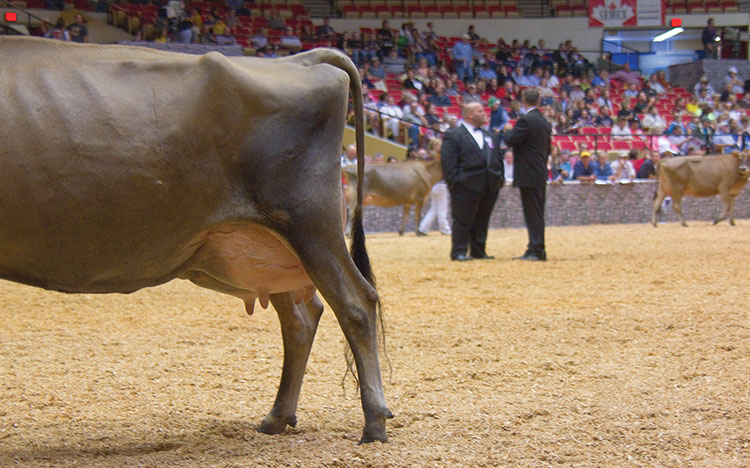
What you need to know
The most important changes exhibitors should note are a step away from the traditional point breakdowns and the reclassification of some discriminations. Evaluation criteria are no longer grouped into the three major categories with point values: appearance of animal, appearance of exhibitor, and showing animal in the ring. In place of the factors to be evaluated and points breakdown, showmanship evaluations now will be categorized on three severities of discrimination for the exhibitor and animal: slight, moderate, and severe. Compliance with the criteria evaluated in these categories will be based on the judge's interpretation of the degree to which a problem was present.
Prefacing the new scorecard is a statement that covers the previous condition and grooming of the animal categories:
"It is important that participants in showmanship ensure that their animal is in proper body condition and growth based on the age of the animal. Horns are to be removed at an appropriate age to provide a safer environment for the leadsperson. Feet should be properly trimmed to promote ease of movement for the animal. These practices will show good husbandry skills of the participant as well as a positive image for the dairy industry."
When judging showmanship, the PDCA now recommends the following levels of discrimination, with some expectations being age appropriate.
May not impact placings
A slight discrimination has little effect on final placing unless the class is extremely close and the contestants are of near equal merit. It is possible that a slight discrimination may not change the final placing.
Slight discriminations - exhibitor:
- Inappropriate halter
- Lead strap tightly looped
- Walks slowly backward into the ring
- Sidesteps when leading calf
- Has stiff outstretched arm
- Has poor posture - overly stiff or slumped
- Improper head carriage - nose is too high
- Animal's head is not turned slightly toward judge when hide is felt
- Stepping on or kicking at the animal's front feet (a slight touch to move animal's front feet is allowed and should not be discriminated against)
- Inappropriate size of animal for competitor
- Minor instances of animal not handling well
- Is not alert
- Muzzle is not wiped clean
- Switch is not brushed and fluffed
- Clipping lines not properly blended
- Moderate discriminations impact a final placing to the degree to which the problem was present. The judge must make the decision and place the exhibitor according to his or her best judgment.
- Not wearing white clothing or show approved attire
- Inappropriate attire that draws attention
- Wearing clothing with a logo
- Does not know birth date, fresh date, breeding date, or due date
- Unable to recognize type faults of the animal
- Halter not fitting or put together properly
- Has fingers in ring of the halter
- Failure to hold throat when needed
- Improper head carriage - head held too low
- Unable to show animal to best advantage
- Slow response to judge or ring official
- Inattentiveness
- Watching the judge too intently
- Overshowing
- Leading too slowly
- Has elbow or hands up
- Is too far to outside or inside of ring
- Incorrect spacing to the animal in front
- Failure to switch rear legs when the judge moves around the animal - on heifers the rear leg nearest the judge is back; milking and dry cows, rear leg nearest the judge is forward
- Doesn't walk quickly into line
- Crowding or bumping others when in line
- Leaving extra space in line
- Failure to maintain a straight lineup
- Moves excessively in line
- Unable to back up animal
- Legs incorrectly posed
- Does not keep animal straight from head to tail
- Chewing gum
- Legs not clipped
- Dirt or dust in hair coat
- Dirt or wax in ears
- Feet not cleaned
- Excessive use of hair sprays, powder, or other fitting products
- Clipping too early - hair appears too long
- Incomplete clipping
- Excessive clipping
Serious discriminations will have a significant effect on the final placing. Usually exhibitors demonstrating one of these behaviors will be placed in the lower half of the class. A general guideline is to place the animal about three fourths of the way down with adjustment up or down depending on the quality of other contestants.
Serious discrimination - exhibitor
- Lead strap looped and fastened
- Striking the animal
- Positioning the rear legs by stepping on feet
- Fusses with or moves calf to the extreme
- Minor instances of unsportsmanlike conduct
- Late to class
- Wearing inappropriate shoes
- Chewing tobacco
- Carries or talks on a cellphone
- Serious discrimination - animal
- Animal causing disturbances to other
- Violate the PDCA Show Ring Code of Ethics
- Exhibit unsportsmanlike conduct
- Repeatedly strike the animal
- Topline is groomed, doesn't distract from the animal's overall appearance, and conforms to the guidelines of the PDCA Show Ring Code of Ethics
"The maximum allowable length of naturally growing hair anywhere on the topline is not to exceed 1 inch. Exhibitors will be required to comply with this rule before the animal is allowed to enter the ring."
Awareness and avoidance of moderate to severe discriminations, along with practice and hard work at home, can help you place at the top of your showmanship class.
The new PDCA showmanship evaluation card can be downloaded. It contains the new guidelines outlined above.
This is the first article in a three-part series on the new PDCA showmanship scorecard.
It appears on page 172 of the March 10, 2012 issue of Hoard's Dairyman.
More in this showmanship series:
March 25: Aligning education and evaluation
"Leading to Win," contains an official copy of the newly released PDCA scorecard. It can be purchased from the Hoard's Dairyman Bookstore, www.hoards.com/bookstore, for $5 in the U.S. An additional "Leading to Win" DVD can be purchased for $15 to view exhibitors demonstrating appropriate showmanship techniques.









